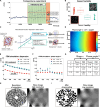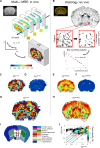Making sense of scattering: Seeing microstructure through shear waves
- PMID: 39083612
- PMCID: PMC11290519
- DOI: 10.1126/sciadv.adp3363
Making sense of scattering: Seeing microstructure through shear waves
Abstract
The physics of shear waves traveling through matter carries fundamental insights into its structure, for instance, quantifying stiffness for disease characterization. However, the origin of shear wave attenuation in tissue is currently not properly understood. Attenuation is caused by two phenomena: absorption due to energy dissipation and scattering on structures such as vessels fundamentally tied to the material's microstructure. Here, we present a scattering theory in conjunction with magnetic resonance imaging, which enables the unraveling of a material's innate constitutive and scattering characteristics. By overcoming a three-order-of-magnitude scale difference between wavelength and average intervessel distance, we provide noninvasively a macroscopic measure of vascular architecture. The validity of the theory is demonstrated through simulations, phantoms, in vivo mice, and human experiments and compared against histology as gold standard. Our approach expands the field of imaging by using the dispersion properties of shear waves as macroscopic observable proxies for deciphering the underlying ultrastructures.
Figures





Similar articles
-
Magnetic resonance perfusion for differentiating low-grade from high-grade gliomas at first presentation.Cochrane Database Syst Rev. 2018 Jan 22;1(1):CD011551. doi: 10.1002/14651858.CD011551.pub2. Cochrane Database Syst Rev. 2018. PMID: 29357120 Free PMC article.
-
Signs and symptoms to determine if a patient presenting in primary care or hospital outpatient settings has COVID-19.Cochrane Database Syst Rev. 2022 May 20;5(5):CD013665. doi: 10.1002/14651858.CD013665.pub3. Cochrane Database Syst Rev. 2022. PMID: 35593186 Free PMC article.
-
Characterizing Musculoskeletal Tissue Mechanics Based on Shear Wave Propagation: A Systematic Review of Current Methods and Reported Measurements.Ann Biomed Eng. 2022 Jul;50(7):751-768. doi: 10.1007/s10439-022-02935-y. Epub 2022 Mar 31. Ann Biomed Eng. 2022. PMID: 35359250 Free PMC article.
-
Integrating Gut Microbiome and Metabolomics with Magnetic Resonance Enterography to Advance Bowel Damage Prediction in Crohn's Disease.J Inflamm Res. 2025 Jun 11;18:7631-7649. doi: 10.2147/JIR.S524671. eCollection 2025. J Inflamm Res. 2025. PMID: 40535353 Free PMC article.
-
Magnetic resonance imaging for the diagnosis of hepatocellular carcinoma in adults with chronic liver disease.Cochrane Database Syst Rev. 2022 May 6;5(5):CD014798. doi: 10.1002/14651858.CD014798.pub2. Cochrane Database Syst Rev. 2022. PMID: 35521901 Free PMC article.
References
-
- Schmitt J. M., Kumar G., Turbulent nature of refractive-index variations in biological tissue. Opt. Lett. 21, 1310–1312 (1996). - PubMed
-
- Xu M., Alfano R. R., Fractal mechanisms of light scattering in biological tissue and cells. Opt. Lett. 30, 3051–3053 (2005). - PubMed
-
- Barthelemy P., Bertolotti J., Wiersma D. S., A Lévy flight for light. Nature 453, 495–498 (2008). - PubMed
-
- Page J. H., Sheng P., Schriemer H. P., Jones I., Jing X., Weitz D. A., Group velocity in strongly scattering media. Science 271, 634–637 (1996).
-
- Tourin A., Fink M., Derode A., Multiple scattering of sound. Waves Random Media 10, R31 (2000).
Publication types
MeSH terms
LinkOut - more resources
Full Text Sources
Medical

